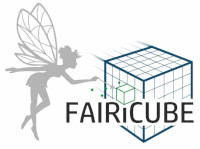The 16th of April WUR hosted a webinar on Use Case2 (UC2): Agriculture and biodiversity nexus. After an introduction of Stefan Jetschny on FAIRiCUBE, WENR colleagues Marian Vittek, Rob Knapen, Masoume Raeissi presented the preliminary outcomes of UC2 so far: an approach to use Causal AI to assess the impact of farming activities on the environment and biodiversity. The expected result is a prototype of a model that predicts causal relations between changes in farmland bird biodiversity and specific agricultural practices in NL (such as woody landscape elements, grassland mowing intensity, crop type, winter condition of crop parcels and annual greenness).
This model can provide a step forward in making more precise estimates of biodiversity in a spatial context, by linking biodiversity with human activities in agricultural areas and related changes in the physical conditions. As such, the model can be used by decision makers in the field of agriculture and environmental protection to support better-informed decisions such as selecting more nature-inclusive practices promoting biodiversity. WENR colleagues introduced three possible model applications in bird conservation in NL:
ZONING: The results of the Observation and Estimation steps for biodiversity can be used to categorize agricultural landscapes and e.g. administrative regions, based on predicted suitability. For example, the agricultural landscape in Gelderland has a 30% higher predicted suitablity for the ‘Geelgors’ than the Flevopolder.
CASUAL MODELING: Causal modelling allows reasoning about counterfactual situations to answer ‘What-if?” type of questions. For example: What is the predicted change in biodiversity for a specific farmland bird species when the woody landscape elements in a specific agricultural region are increased by 10%?
SMART TOOLS: The presented approach aims at improved understanding of causalities between farm activities and changes in biodiversity. When results are sufficiently robust, the model could be incorporated into advisory tools for farmers or policy makers, to help assess the consequences of actions.
Presentations were followed by two interactive sessions facilitated by Giulia Salvini (WENR). The first one aimed at collecting feedback from biodiversity experts on the environmental and agricultural variables used in the model, the main model components and the correlations explored so far. The second session was aimed to gather feedback on the possible applications of the model for farmland bird conservation (zoning, casual modeling and smart tooling). The webinar concluded with a discussion on broader ethical and feasibility issues: How accurate should the model be? What are the ethical implications of using AI for biodiversity conservation in agricultural landscape? How likely will such a model be adopted? The recordings of the seminar are available here.The presentation can be found below.
And what do you think? Is AI still science fiction or a close reality? Do you think these potential products would support biodiversity conservation in NL or Europe? Would you like to share your thoughts on this or are you curious about the final results? Stay tuned!

